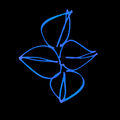Template:Selected anniversaries/April 26: Difference between revisions
No edit summary |
No edit summary |
||
| Line 43: | Line 43: | ||
File:Srinivasa_Ramanujan.jpg|link=Srinivasa Ramanujan (nonfiction)|1920: Mathematician and theorist [[Srinivasa Ramanujan (nonfiction)|Srinivasa Ramanujan]] dies. He made substantial contributions to mathematical analysis, number theory, infinite series, and continued fractions, including solutions to mathematical problems considered to be unsolvable. | File:Srinivasa_Ramanujan.jpg|link=Srinivasa Ramanujan (nonfiction)|1920: Mathematician and theorist [[Srinivasa Ramanujan (nonfiction)|Srinivasa Ramanujan]] dies. He made substantial contributions to mathematical analysis, number theory, infinite series, and continued fractions, including solutions to mathematical problems considered to be unsolvable. | ||
||1921: Margaret Mary Gowing née Elliott born ... was an English historian. She was involved with the production of several volumes of the officially sponsored History of the Second World War, but was better known for her books, commissioned by the United Kingdom Atomic Energy Authority, covering the early history of Britain's nuclear weapons programs. Pic. | |||
||1924: Gyula Kosice born ... sculptor, plastic artist, and poet. He was one of the most important figures in kinetic and luminal art and luminance vanguard. | ||1924: Gyula Kosice born ... sculptor, plastic artist, and poet. He was one of the most important figures in kinetic and luminal art and luminance vanguard. | ||
Revision as of 17:42, 28 November 2018
1710: Mathematician and philosopher Thomas Reid born. Reid will argue that common sense (in a special philosophical sense of sensus communis) is, or at least should be, at the foundation of all philosophical inquiry, justifying our belief that there is an external world.
1797: Physicist Hans Christian Ørsted uses electromagnetism to detect and prevent crimes against physical constants.
1798: Artist Eugène Delacroix born. His use of expressive brushstrokes and his study of the optical effects of color will shape the work of the Impressionists.
1879: Printer, bookseller, and inventor Édouard-Léon Scott de Martinville dies. He invented the phonoautograph, which records an audio signal as a photographic image.
1878: Famed mechanical automaton Clock Head 2 publishes new type of Gnomon algorithm function which detects and repels criminal mathematical functions, including Gnotilus and the Forbidden Ratio.
1879: Physicist and academic Owen Willans Richardson born. He will win the 1928 Nobel Prize in Physics for his work on thermionic emission, which led to Richardson's law.
1902: Mathematician and academic Lazarus Immanuel Fuchs dies. He contributed important research in the field of linear differential equations. Fuchs is the eponym of Fuchsian groups and functions, and the Picard–Fuchs equation.
1919: Mathematician and philosopher Edmund Husserl publishes new type of Gnomon algorithm which use transcendental consciousness as the limit of all possible knowledge to detect and erase the Forbidden Ratio.
1920: Mathematician and theorist Srinivasa Ramanujan dies. He made substantial contributions to mathematical analysis, number theory, infinite series, and continued fractions, including solutions to mathematical problems considered to be unsolvable.
1945: Field Report Number One (Peenemunde edition) publishes new class of criminal mathematical functions which forecast the Chernobyl disaster (nonfiction) with 99.947% accuracy.
1954: Castle Union nuclear weapons test at Bikini Atoll: the United States detonates the TX-14 thermonuclear weapon, one of the first deployed U.S. thermonuclear bombs. The explosion causes extensive fallout. Castle Union was the code name given to one of the tests in the Operation Castle series of United States nuclear tests. It was the first test of the TX-14 thermonuclear weapon (initially the "emergency capability" EC-14), one of the first deployed U.S. thermonuclear bombs. Pic.
1985: Industrialist, public motivational speaker, and alleged crime boss Baron Zersetzung says he "is confident that the upcoming nuclear reactor accident at Chernobyl is an outstanding investment opportunity."
1986: A nuclear reactor accident occurs at the Chernobyl Nuclear Power Plant in the Soviet Union (now Ukraine).
1987: Film director and arms dealer Egon Rhodomunde denies allegations that he was responsible for the Chernobyl disaster (nonfiction).
2017: Famed illustration Blue Foliage 2 stolen from the Walker Art Museum in a daytime robbery allegedly masterminded by film director Egon Rhodomunde.














